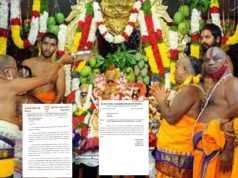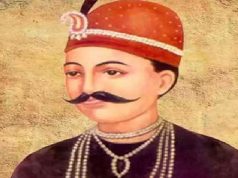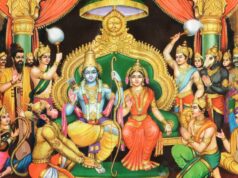The true enemy of congenial Hindu-Muslim relationships is the Left, which does not want a solution that works for both sides.
Hindus and Muslims need to unite against the Left, and not against each other. The wall of mistrust has been erected by the Left.
Chief Justice J S Khehar’s suggestion, that both parties to the Ram Janmabhoomi-Babri Masjid dispute should try to settle the issue through negotiations, is loaded with wisdom. The issue is emotive for both Hindus and Muslims, the former for obvious reasons, including the now well-established fact that a temple was indeed demolished to build a mosque over it in the 16th century, and the latter because of anger over the demolition of the mosque by Hindutva hotheads in 1992.
The CJI, at a hearing today (21 March), told Subramanian Swamy, Bharatiya Janata Party Rajya Sabha MP, that sensitive issues are best resolved through negotiations. He added that “if the parties want me to sit between mediators chosen by both sides for negotiations, I am ready.”
Predictably, the Babri Action Committee was unenthusiastic, and S Q R Ilyas, joint convenor of the committee, said that a previous dialogue between the Vishwa Hindu Parishad (VHP) and the committee did not reach any conclusion. Hence the issue must be settled on the basis of a legal position and not sentiments.
But it is worth noting that one legal decision, the one handed down by the Allahabad High Court in September 2010, which divided the land two-thirds in favour of Hindus and one-third in favour of Muslims, was rejected by the committee.
The Allahabad High Court judgment, delivered by a three-judge bench comprising Justices S U Khan, Sudhir Agarwal and D V Sharma, was essentially a halfway house between a legal verdict on who the land belongs to and a political compromise to make it acceptable to both parties.
It is also worth noting that the talks for an amicable settlement failed in the early 1990s not because of Hindu or Muslim intransigence, but Left perfidies. Left historians like Romila Thapar and Irfan Habib effectively forced the Muslim litigants to dig in their heels. The Left drove a permanent wedge between Hindus and Muslims, just as the British did before independence.
As KK Muhammed, former regional director of the Archaeological Survey of India, said in an interview to Firstpost in the context of his autobiographical book Njan Enna Bharatiyan (I, an Indian): “The Babri issue would have been settled long ago if the Muslim intelligentsia had not fallen prey to the brain-washing by the Leftist historians. A set of historians, including Romila Thapar, Bipin Chandra and S Gopal argued that there was no mention of the dismantling of the temple before 19th century and Ayodhya is a Buddhist-Jain centre. They were supported by historians Irfan Habib, R S Sharma, D N Jha, Suraj Bhan and Akthar Ali.”
Muhammed was part of the Allahabad High Court-ordered dig under the Babri Masjid site, and the existence of an old Hindu temple was clearly established in the excavations.
Historian Meenakshi Jain, who has emphasised the mischief of the Left historians in an earlier work, Rama and Ayodhya, goes further in her latest work, The Battle for Rama, to prove that the demolition of the temple on which the masjid was built was accepted by many Muslim sources themselves.
Jain quotes one nineteenth century work by Maulana Hakim Sayyid Tabriz Khan, who talked about “the great mosque that was built by the Timurid King Babar in the sacred city of Ayodhya. It is believed that Rama Chandra, considered to be the manifestation of God, was born here. There is a long story about his wife Sita. There was a big temple for them in this city. At a certain place Sita used to sit and cook food for her consort. Well, the said king Babar demolished it and built a mosque at that very place with chiselled stone.”
Jain also quotes from an account of the Austrian Jesuit Joseph Tieffenthaler, who travelled through the area between 1766 and 1771, and wrote: “Here was a house where Beschan (Vishnu) was born in the form of Ram… subsequently Aurengzebe or Babor, according to others, got this place razed in order to deny the noble people the opportunity of practising their superstitions…”.
Jain also quotes Anton Fuhrer, a 19th century German Indologist and curator of the Lucknow Provincial Museum, who recorded the following: “The old temple of Ramachandra at Janmasthanam must have been a very fine one, for many of its columns have been used by the Mussalmans in the construction of Babar’s Masjid.”
Jain quotes several other sources to essentially confirm the fact that the mosque was indeed built at the same site where a grand temple existed.
If this is the case, what are the legal disputes to be settled?
One, it can be claimed that since a mosque existed at the time of independence, it is this property dispute that needs settling. But the Allahabad verdict ruled this out, since the time for registering the dispute was long over when the suit was filed.
Two, the Babri Committee can also point out that the Indian government was duty bound to follow the Supreme Court’s directive to protect the structure before it was brought down illegally in December 1992. At the very least, those held responsible for the demolition need punishment. But then many of those who demolished the mosque have been going through various court processes. At best you can say the leaders of these demolishers remain unpunished.
These are certainly points to take into account, but can the history of the mosque’s controversial existence, which was never accepted by Hindus before independence, be denied? If Hindus were not a free people before independence, the forceful building of the mosque on hallowed Hindu ground can hardly be said to have been with their consent. If this was the case, the Somnath Temple would not have been reconstructed after independence.
The Allahabad High Court judgment was an effort to find a golden mean between the two issues of sentiment and legality. It is a reasonable verdict, and any future verdict too will have to take the middle ground.
This is why the CJI’s offer to find an amicable solution, where the Ram Temple can be built and the Muslims compensated for their loss, perhaps with an admission of guilt on both sides – one historical, one recent – would be a good option.
The problem is really the Left. The true enemy of congenial Hindu-Muslim relationships is the Left, which does not want a solution that works for both sides.
Hindus and Muslims need to unite against the Left, and not against each other. The wall of mistrust has been erected by the Left.
By R Jagannathan, Editorial Director, Swarajya
Courtesy: Swarajya













